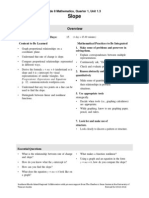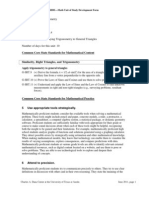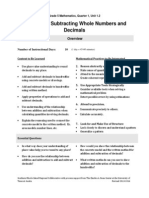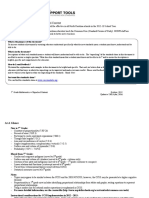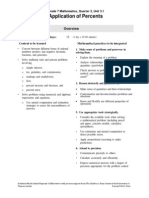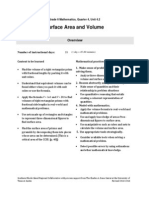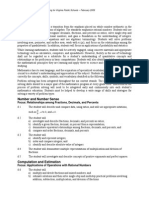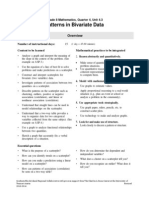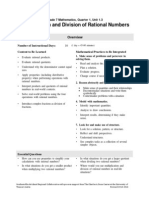Using Definitions and Geometric Properties: Geometry, Quarter 1, Unit 1.1
Using Definitions and Geometric Properties: Geometry, Quarter 1, Unit 1.1
Uploaded by
rmullen82Copyright:
Available Formats
Using Definitions and Geometric Properties: Geometry, Quarter 1, Unit 1.1
Using Definitions and Geometric Properties: Geometry, Quarter 1, Unit 1.1
Uploaded by
rmullen82Original Title
Copyright
Available Formats
Share this document
Did you find this document useful?
Is this content inappropriate?
Copyright:
Available Formats
Using Definitions and Geometric Properties: Geometry, Quarter 1, Unit 1.1
Using Definitions and Geometric Properties: Geometry, Quarter 1, Unit 1.1
Uploaded by
rmullen82Copyright:
Available Formats
Geometry, Quarter 1, Unit 1.
Using Definitions and Geometric Properties
Overview Number of instructional days: Content to be learned
Use geometric shapes to define and measure everyday objects. Know precise definitions of geometric terms. Develop definitions of transformations with regard to geometric objects. Create formal geometric constructions with a variety of tools and methods. Prove geometric theorems algebraically.
10
(1 day = 45 minutes)
Mathematical practices to be integrated
Model with mathematics. Use models of geometric properties through geometric constructions. Model and develop definitions of rotations, reflections, and translations. Use geometric shapes, their measures, and their properties to describe objects.
Attend to precision. Use clear definitions in discussion with others. Examine claims and make explicit use of definitions.
Look for and make use of structure. Verify definitions of geometric properties through constructions. Use coordinates to prove simple geometric theorems algebraically.
Essential questions
What definitions are imperative to have a thorough understanding of geometry? What are the similarities and differences between geometric and algebraic transformations? How does a construction help solidify understanding of proofs of geometric figures? Where are ratios needed in the study of geometry? Why is it important to apply geometric properties to common objects?
Warwick Public Schools, in collaboration with the Charles A. Dana Center at the University of Texas at Austin
C-1
Geometry, Quarter 1, Unit 1.1 2011-2012
Using Definitions and Geometric Properties (10 days)
Written Curriculum Common Core State Standards for Mathematical Content
Geometry
Modeling with Geometry
Apply geometric concepts in modeling situations G-MG.1 Use geometric shapes, their measures, and their properties to describe objects (e.g., modeling a tree trunk or a human torso as a cylinder).
G-MG
Congruence
Experiment with transformations in the plane G-CO.1
G-CO
Know precise definitions of angle, circle, perpendicular line, parallel line, and line segment, based on the undefined notions of point, line, distance along a line, and distance around a circular arc. Develop definitions of rotations, reflections, and translations in terms of angles, circles, perpendicular lines, parallel lines, and line segments.
G-CO.4
Make geometric constructions [Formalize and explain processes] G-CO.12 Make formal geometric constructions with a variety of tools and methods (compass and straightedge, string, reflective devices, paper folding, dynamic geometric software, etc.). Copying a segment; copying an angle; bisecting a segment; bisecting an angle; constructing perpendicular lines, including the perpendicular bisector of a line segment; and constructing a line parallel to a given line through a point not on the line.
Expressing Geometric Properties with Equations
G-GPE
Use coordinates to prove simple geometric theorems algebraically [Include distance formula; relate to Pythagorean theorem] G-GPE.6 Find the point on a directed line segment between two given points that partitions the segment in a given ratio.
Common Core State Standards for Mathematical Practice
4 Model with mathematics.
Mathematically proficient students can apply the mathematics they know to solve problems arising in everyday life, society, and the workplace. In early grades, this might be as simple as writing an addition equation to describe a situation. In middle grades, a student might apply proportional reasoning to plan a school event or analyze a problem in the community. By high school, a student might use geometry to solve a design problem or use a function to describe how one quantity of interest depends on another. Mathematically proficient students who can apply what they know are comfortable making assumptions and approximations to simplify a complicated situation, realizing that these may need revision later. They
C-2 Warwick Public Schools, in collaboration with the Charles A. Dana Center at the University of Texas at Austin
Using Definitions and Geometric Properties (10 days)
Geometry, Quarter 1, Unit 1.1 2011-2012
are able to identify important quantities in a practical situation and map their relationships using such tools as diagrams, two-way tables, graphs, flowcharts and formulas. They can analyze those relationships mathematically to draw conclusions. They routinely interpret their mathematical results in the context of the situation and reflect on whether the results make sense, possibly improving the model if it has not served its purpose. 5 Use appropriate tools strategically.
Mathematically proficient students consider the available tools when solving a mathematical problem. These tools might include pencil and paper, concrete models, a ruler, a protractor, a calculator, a spreadsheet, a computer algebra system, a statistical package, or dynamic geometry software. Proficient students are sufficiently familiar with tools appropriate for their grade or course to make sound decisions about when each of these tools might be helpful, recognizing both the insight to be gained and their limitations. For example, mathematically proficient high school students analyze graphs of functions and solutions generated using a graphing calculator. They detect possible errors by strategically using estimation and other mathematical knowledge. When making mathematical models, they know that technology can enable them to visualize the results of varying assumptions, explore consequences, and compare predictions with data. Mathematically proficient students at various grade levels are able to identify relevant external mathematical resources, such as digital content located on a website, and use them to pose or solve problems. They are able to use technological tools to explore and deepen their understanding of concepts. 6 Attend to precision.
Mathematically proficient students try to communicate precisely to others. They try to use clear definitions in discussion with others and in their own reasoning. They state the meaning of the symbols they choose, including using the equal sign consistently and appropriately. They are careful about specifying units of measure, and labeling axes to clarify the correspondence with quantities in a problem. They calculate accurately and efficiently, express numerical answers with a degree of precision appropriate for the problem context. In the elementary grades, students give carefully formulated explanations to each other. By the time they reach high school they have learned to examine claims and make explicit use of definitions. 7 Look for and make use of structure.
Mathematically proficient students look closely to discern a pattern or structure. Young students, for example, might notice that three and seven more is the same amount as seven and three more, or they may sort a collection of shapes according to how many sides the shapes have. Later, students will see 7 8 equals the well remembered 7 5 + 7 3, in preparation for learning about the distributive property. In the expression x2 + 9x + 14, older students can see the 14 as 2 7 and the 9 as 2 + 7. They recognize the significance of an existing line in a geometric figure and can use the strategy of drawing an auxiliary line for solving problems. They also can step back for an overview and shift perspective. They can see complicated things, such as some algebraic expressions, as single objects or as being composed of several objects. For example, they can see 5 3(x y)2 as 5 minus a positive number times a square and use that to realize that its value cannot be more than 5 for any real numbers x and y.
Warwick Public Schools, in collaboration with the Charles A. Dana Center at the University of Texas at Austin
C-3
Geometry, Quarter 1, Unit 1.1 2011-2012
Using Definitions and Geometric Properties (10 days)
Clarifying the Standards Prior Learning
In grade 6, students built on their work with area in elementary school by reasoning about relationships among shapes to determine area, surface area, and volume. Using these methods, students discussed, developed, and justified formulas for areas of triangles and parallelograms. They drew polygons in the coordinate plane. In grade 7, students learned about angle measures, protractors, and describing two-dimensional figures. Students solved problems involving the area and circumference of a circle and surface area of threedimensional objects. They reasoned about relationships among two-dimensional figures using scale drawings and informal geometric constructions, and they gained familiarity with the relationships between angles formed by intersecting lines. Students worked with three-dimensional figures, relating them to two-dimensional figures by examining cross-sections. They solved real-world and mathematical problems involving area, surface area, and volume of two- and three-dimensional objects composed of triangles, quadrilaterals, polygons, cubes and right prisms. In grade 8, students learned about angles with the same measure, line segments, parallel lines, perpendicular lines, and properties of rotations, reflections, and translations. Students used ideas about distance and angles, how they behave under translations, rotations, reflections, and dilations, and ideas about congruence and similarity to describe and analyze two-dimensional figures and to solve problems. Students showed that the sum of the angles in a triangle is the angle formed by a straight line, and that various configurations of lines give rise to similar triangles because of the angles created when a transversal cuts parallel lines. Students completed their work on volume by solving problems involving cones, cylinders, and spheres.
Current Learning
Geometry students learn to describe geometric properties and formal definitions of angle, circle, perpendicular line, parallel line, and line segment, based on the undefined notions of point, line, and distance along a line; develop and use formal definitions of rotations, reflections, and translations in terms of angles, circles, perpendicular lines, parallel lines, and line segments; and find the point on a directed line segment between two given points that partitions the segment in a given ratio; and formal geometric constructions based on definitions of geometric properties.
Future Learning
Students will continue to use algebraic methods to solve problems in algebra 2 and fourth-year mathematics courses. Students will use geometric descriptions in real-world situations outside of high school. Future work applications will include engineering, construction, and computer sciences.
Additional Findings
A Research Companion to Principles and Standards for School Mathematics indicates that students can establish theorems within an axiomatic system. They recognize the difference among undefined terms, definitions, axioms, and theorems. Students are then able to construct proofs; that is, producing a sequence of statements that logically justify a conclusion as a consequence of the givens. Research supports this method of creating precise understandings to geometric properties, definitions, axioms, and theorems, creating environments that encourage logical thinking (p. 153).
C-4 Warwick Public Schools, in collaboration with the Charles A. Dana Center at the University of Texas at Austin
You might also like
- Geo 1 4Document4 pagesGeo 1 4rmullen82No ratings yet
- Transformations: Geometry, Quarter 1, Unit 1.2Document4 pagesTransformations: Geometry, Quarter 1, Unit 1.2rmullen82No ratings yet
- Grade 8 Sorico Math Unit 3 3 2013-2014Document4 pagesGrade 8 Sorico Math Unit 3 3 2013-2014api-233707670No ratings yet
- Unit of Study - Transformations 2016Document5 pagesUnit of Study - Transformations 2016api-270891801No ratings yet
- Grade 7 Sorico Math Unit 3 3 2013-2014Document4 pagesGrade 7 Sorico Math Unit 3 3 2013-2014api-233707670No ratings yet
- Grade 3 Sorico Math Unit 1 2 2013-2014Document4 pagesGrade 3 Sorico Math Unit 1 2 2013-2014api-233707670No ratings yet
- Grade 8 MathematicsDocument4 pagesGrade 8 MathematicsWandaNo ratings yet
- Grade 7 Sorico Math Unit 4 2 2013-2014Document3 pagesGrade 7 Sorico Math Unit 4 2 2013-2014api-233707670No ratings yet
- Grade 8 Sorico Math Unit 3 2 2013-2014Document4 pagesGrade 8 Sorico Math Unit 3 2 2013-2014api-233707670No ratings yet
- Grade Level/course: Geometry Quarter: 2 Unit of Study Number: 2.2 Unit of Study Title: Similarity Number of Days For This Unit: 12Document4 pagesGrade Level/course: Geometry Quarter: 2 Unit of Study Number: 2.2 Unit of Study Title: Similarity Number of Days For This Unit: 12rmullen82No ratings yet
- Grade 8 Sorico Math Unit 1 3 2013-2014Document4 pagesGrade 8 Sorico Math Unit 1 3 2013-2014api-233707670No ratings yet
- Geometric Congruence: Geometry, Quarter 1, Unit 1.3Document4 pagesGeometric Congruence: Geometry, Quarter 1, Unit 1.3rmullen82No ratings yet
- Grade Level/course: Geometry Quarter: 2 Unit of Study Number: 2.3 Unit of Study Title: Right Triangle Trigonometry Number of Days For This Unit: 8Document4 pagesGrade Level/course: Geometry Quarter: 2 Unit of Study Number: 2.3 Unit of Study Title: Right Triangle Trigonometry Number of Days For This Unit: 8rmullen82No ratings yet
- Geometry, Quarter 2, Unit 2.1 Congruent PolygonsDocument3 pagesGeometry, Quarter 2, Unit 2.1 Congruent Polygonsrmullen82No ratings yet
- Grade 7 Introduction: Print This PageDocument3 pagesGrade 7 Introduction: Print This Pageapi-282583504No ratings yet
- 7th Grade Math StandardsDocument4 pages7th Grade Math Standardsapi-331816611No ratings yet
- Grade 7 Sorico Math Unit 4 1 2013-2014Document4 pagesGrade 7 Sorico Math Unit 4 1 2013-2014api-233707670100% (1)
- Geo 2 4Document3 pagesGeo 2 4rmullen82No ratings yet
- Grade 8 Sorico Math Unit 4 2 2013-2014Document3 pagesGrade 8 Sorico Math Unit 4 2 2013-2014api-233707670100% (1)
- Grade 8 Sorico Math Unit 2 1 2013-2014Document5 pagesGrade 8 Sorico Math Unit 2 1 2013-2014api-233707670No ratings yet
- CcssDocument10 pagesCcssapi-2372294750% (1)
- 8 Grade Mathematics Unpacked Content: What Is The Purpose of This Document?Document42 pages8 Grade Mathematics Unpacked Content: What Is The Purpose of This Document?baboosabNo ratings yet
- Grade 5 Sorico Math Unit 1 2 2013-2014Document4 pagesGrade 5 Sorico Math Unit 1 2 2013-2014api-233707670No ratings yet
- Lesson 6 Mathematical ObjectsDocument17 pagesLesson 6 Mathematical Objectsuniversity8383No ratings yet
- Grade 09 Principles of Mathematics, MPM1DDocument4 pagesGrade 09 Principles of Mathematics, MPM1DranvijayNo ratings yet
- 7th Grade UnpackedDocument45 pages7th Grade Unpackedapi-262020675No ratings yet
- Math 7 Scope and Sequence 2014-15 v2Document28 pagesMath 7 Scope and Sequence 2014-15 v2api-281653314No ratings yet
- Grade 7 Sorico Math Unit 3 1 2013-2014Document4 pagesGrade 7 Sorico Math Unit 3 1 2013-2014api-233707670100% (1)
- Grade 7 Sorico Math Unit 2 3 2013-2014Document4 pagesGrade 7 Sorico Math Unit 2 3 2013-2014api-233707670No ratings yet
- Grade 8 Sorico Math Unit 4 1 2013-2014Document4 pagesGrade 8 Sorico Math Unit 4 1 2013-2014api-233707670No ratings yet
- 8 Mathematical PracticesDocument2 pages8 Mathematical PracticesLAUSDCCSSNo ratings yet
- Grade 6 Sorico Math Unit 4 2 2013-2014Document5 pagesGrade 6 Sorico Math Unit 4 2 2013-2014api-233707670No ratings yet
- 7th Grade UnpackedDocument45 pages7th Grade Unpackedapi-263084168No ratings yet
- Rules of Exponents and Scientific Notation: Grade 8 Mathematics, Quarter 1, Unit 1.1Document4 pagesRules of Exponents and Scientific Notation: Grade 8 Mathematics, Quarter 1, Unit 1.1api-270891801No ratings yet
- Stds Math6Document2 pagesStds Math6api-262305377No ratings yet
- Unit Plan Cartesian Planes Year 5:6Document18 pagesUnit Plan Cartesian Planes Year 5:6magicklaxonNo ratings yet
- Grade 8 Sorico Math Unit 3 1 2013-2014Document4 pagesGrade 8 Sorico Math Unit 3 1 2013-2014api-233707670100% (1)
- Grade 8 Sorico Math Unit 4 3 2013-2014Document4 pagesGrade 8 Sorico Math Unit 4 3 2013-2014api-233707670100% (1)
- Algebra 1 - Course OverviewDocument5 pagesAlgebra 1 - Course OverviewKayecee Delos SantosNo ratings yet
- Grade 2 Sorico Math Unit 1 3 2013-2014Document4 pagesGrade 2 Sorico Math Unit 1 3 2013-2014api-233707670No ratings yet
- Grade 7 Sorico Math Unit 1 2 2013-2014Document5 pagesGrade 7 Sorico Math Unit 1 2 2013-2014api-233707670No ratings yet
- Grade 7 Sorico Math Unit 1 3 2013-2014Document4 pagesGrade 7 Sorico Math Unit 1 3 2013-2014api-233707670No ratings yet
- 4 3ParagraphsGeomDocument2 pages4 3ParagraphsGeomamitbahl75No ratings yet
- Geometry: Approximate Grade Level: 9 - 10 M/W or T/TH 11:00 AM - 11:55 AM Course DescriptionDocument3 pagesGeometry: Approximate Grade Level: 9 - 10 M/W or T/TH 11:00 AM - 11:55 AM Course Descriptionapi-308781855No ratings yet
- Grade 6 Sorico Math Unit 3 1 2013-2014Document5 pagesGrade 6 Sorico Math Unit 3 1 2013-2014api-233707670No ratings yet
- Acc Unit 1 3 Unit of StudyDocument6 pagesAcc Unit 1 3 Unit of Studyapi-270891801No ratings yet
- Curriculum Map Math 8thDocument41 pagesCurriculum Map Math 8thapi-241650432No ratings yet
- Modul MTK KLS 8 Bab 5.1Document14 pagesModul MTK KLS 8 Bab 5.1Gunawan CHtNo ratings yet
- Yolanda Shields - Throwing A FootballDocument19 pagesYolanda Shields - Throwing A FootballAltheaGuanzonNo ratings yet
- Modul MTK KLS 8 Bab 1.2Document14 pagesModul MTK KLS 8 Bab 1.2windi711No ratings yet
- 3-5 Mathematics Georgia Performance Standards: Grade 4Document5 pages3-5 Mathematics Georgia Performance Standards: Grade 4grassoj1No ratings yet
- Grade 4 Sorico Math Unit 1 2 2013-2014Document4 pagesGrade 4 Sorico Math Unit 1 2 2013-2014api-233707670100% (1)
- Grade 5 Sorico Math Unit 1 3 2013-2014Document5 pagesGrade 5 Sorico Math Unit 1 3 2013-2014api-233707670No ratings yet
- Cartesian Planes - Plotting Points (Finishing Robot)Document4 pagesCartesian Planes - Plotting Points (Finishing Robot)magicklaxonNo ratings yet
- Solving Equations With One Variable: Grade 8 Mathematics, Quarter, Unit 1.3Document5 pagesSolving Equations With One Variable: Grade 8 Mathematics, Quarter, Unit 1.3api-270891801No ratings yet
- Grade 7 Sorico Math Unit 1 1 2013-2014Document4 pagesGrade 7 Sorico Math Unit 1 1 2013-2014api-233707670No ratings yet
- 1-31-14 II C High School Mathematics Course Standards AttachmentDocument46 pages1-31-14 II C High School Mathematics Course Standards AttachmentMarites Armillo SasutonaNo ratings yet
- 8 ThgradecurriculumDocument5 pages8 Thgradecurriculumapi-254290621No ratings yet
- Geo 2 4Document3 pagesGeo 2 4rmullen82No ratings yet
- Grade Level/course: Geometry Quarter: 2 Unit of Study Number: 2.3 Unit of Study Title: Right Triangle Trigonometry Number of Days For This Unit: 8Document4 pagesGrade Level/course: Geometry Quarter: 2 Unit of Study Number: 2.3 Unit of Study Title: Right Triangle Trigonometry Number of Days For This Unit: 8rmullen82No ratings yet
- Grade Level/course: Geometry Quarter: 2 Unit of Study Number: 2.2 Unit of Study Title: Similarity Number of Days For This Unit: 12Document4 pagesGrade Level/course: Geometry Quarter: 2 Unit of Study Number: 2.2 Unit of Study Title: Similarity Number of Days For This Unit: 12rmullen82No ratings yet
- Geometry, Quarter 2, Unit 2.1 Congruent PolygonsDocument3 pagesGeometry, Quarter 2, Unit 2.1 Congruent Polygonsrmullen82No ratings yet
- Geometric Congruence: Geometry, Quarter 1, Unit 1.3Document4 pagesGeometric Congruence: Geometry, Quarter 1, Unit 1.3rmullen82No ratings yet










